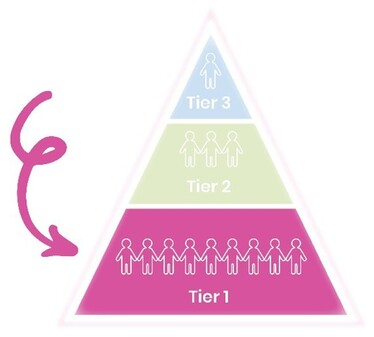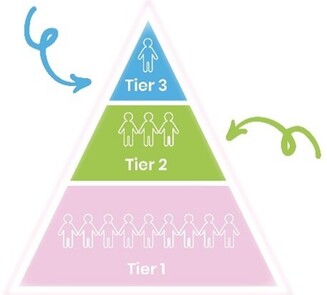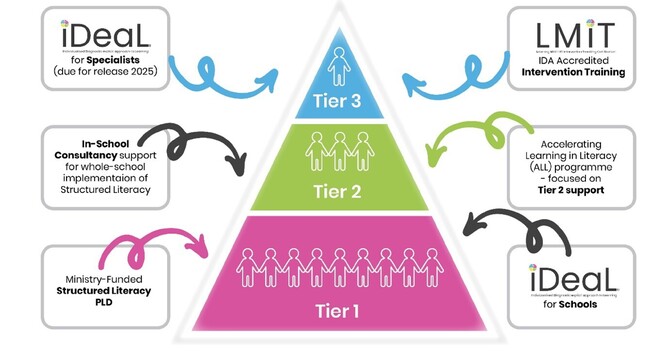With the Ministry of Education’s (MoE) mandate for Structured Literacy taking effect in 2025, literacy education in New Zealand is evolving. This is such an exciting step forward, as it means teachers in Years 0–8 can receive funded professional learning development (PLD) for teaching Structured Literacy. However, there is still much to learn and implement, especially for those supporting our most vulnerable learners in Tiers 2 and 3.
Structured Literacy – diagnostic, systematic, cumulative, and explicit – provides a solid foundation, but its successful application requires a clear roadmap, thoughtful planning, and ongoing support. As systems evolve, consistency across all tiers is critical. We need to build knowledge and practice for all teachers, ensuring strong core Tier 1 instruction, while also deepening understanding of effective Tier 2 instructional practices. Additionally, we must support teachers delivering interventions by equipping them with the knowledge and ensuring that the most qualified Structured Literacy teachers implement Tier 3 intervention support. Are you equipped with the knowledge and resources to truly make a difference for ALL learners across the tiers?
In this blog, we’ll explore what effective support looks like at each level.
Understanding Tier 1: The Foundation for All Learners
Tier 1 instruction provides core literacy education. But what does effective Tier 1 literacy instruction actually look like in schools?
Most children respond well to high-quality instruction, but it's crucial that Tier 1 teaching is truly effective. When done right, it reduces the need for additional support. Effective Tier 1 instruction is explicit, systematic, and teacher-led. While phonics is essential, it's not enough. Instruction must also include cumulative practice, covering all the principles of Structured Literacy – teaching phonics for decoding, ensuring fluency, and integrating comprehension skills.
Literacy blocks should include all elements as outlined by the Ministry of Education: “For the purposes of reading and writing, the elements of structured literacy approaches include phonemic awareness, systematic synthetic phonics teaching and knowledge, fluency, handwriting, comprehension, oral language, vocabulary, syntax, morphology and text structure.” – MoE, 2024.
Without these elements, particularly for at-risk students, they may fail to become proficient readers. In a recent Chit Chat with child neuropsychologist Dr Jack Fletcher, he said, “If all you teach is phonics, you’ll get word callers who don’t understand what they read.”
Instruction must be comprehensive, addressing the alphabetic principle, fluency, and comprehension. The goal is to teach so well that we meet the needs of most students with minimal additional resources. Dr Stephanie Stollar explained in a further Chit Chat, “Tier 1 instruction must be so well matched to the students that it causes the most students to meet year-level expectations.” Universal screening and progress monitoring ensure most learners reach those expectations.
If a significant number of your students require Tier 2 or Tier 3 support, it’s worth starting by evaluating your Tier 1 instruction. There are various ways to differentiate Tier 1 instruction, which will depend on your school’s size and setting. Focus on being efficient and collaborate with colleagues to ensure learners’ needs are met during Tier 1. Begin by thoroughly analysing your data – this is the key to determining the best approach moving forward.
Moving Beyond Tier 1: Supporting Our Vulnerable Learners
Beyond Tier 1, it’s important to recognise that supporting learners in Tiers 2 and 3 demands additional knowledge and strategies from our educators.
Tier 2 interventions should provide an ‘extra dose’ of the same high-quality instruction students receive in the classroom. It involves extra in-class support through small group instruction (4-6 students), focusing on frontloading key concepts, repetition, and increased intensity of previously taught material. As a guide, students requiring Tier 2 instruction will be achieving around 12 months behind curriculum expectations. Alignment between Tier 1 and Tier 2 ensures students are not overwhelmed by conflicting content but instead benefit from additional practice and repetition. Tier 2 also allows for ‘pre-loading’ upcoming material, giving students a chance to experience success alongside their peers during Tier 1 instruction. It is not how the brain learns to read that is different, it is how many exposures and how much guided practice we may need as individuals, therefore the intensity and repetition required for some students is where the variance sits.
Tier 3 interventions are more individualised and intensive, requiring highly qualified, experienced teachers to deliver evidence-based strategies tailored to the student’s needs. Tier 3 supports our most vulnerable learners, requiring highly specialised, intensive instruction from suitably trained and knowledgeable educators. These students present with a significant lag in relation to curriculum expectation and will be more than 12 months behind curriculum expectations.
At this level, consistency across all tiers is crucial, and both the intensity and dosage of instruction are of paramount importance. I want to iterate though that Tier 3 is not simply more of Tiers 1 or 2. It is much more specific, intense, and scaffolded. It is also not our Tier 1 instruction delivered in a small group,1-2 and or 1–1 situation. This is a common misconception of Tier 3 instruction.
Our experience with Tier 2 and Tier 3 instruction during the Literacy Community trial revealed a strong positive correlation between the amount of instructional time (dosage) and improvements in decoding skills. This highlights the critical role of differentiated practice and targeted, individualised support in fostering literacy growth.
During the trial, Tier 2 teachers conducted three 20-minute sessions per week within the classroom, while Tier 3 teachers provided four 30-minute sessions per week outside the classroom. By analysing actual session attendance, we were able to explore the relationship between dosage and its impact, which showed a clear positive correlation between the number of sessions attended and improvements in decoding. Consistent, increased exposure – both in time and intensity – not only benefitted students but also supported the professional development of teachers.
As Dr Stollar highlights, a Multi-Tiered System of Support (MTSS) ensures the instructional approach is integrated and aligned across the tiers. This framework is not just for literacy – it also addresses social, emotional, and behavioural needs, creating an environment where all systems work together to support the student.
Dr Stephanie Stollar comments, "Tier 3 is like the best version of instruction we can give to students, but we can only do that with a small number of students, so it really rests on the base with teaching through a preventative approach at Tier 1."
The Importance of Early Identification and Intervention
Early identification of literacy learning differences is crucial. Universal screening assessments help educators spot students at risk of literacy challenges before they fall behind. The goal isn’t to diagnose learning differences but to recognise early warning signs and intervene promptly. When students don’t respond to high-quality Tier 1 instruction, further assessments can determine if more intensive Tier 2 or Tier 3 interventions are necessary.
But how do we know students require Tier 2 or 3 instruction, and what supports should be in place?
The importance of early screening cannot be overstated. Identifying students at risk is essential, and the most effective screening tools focus on letter-sound knowledge or fluency, especially for five to six year olds. A straightforward measure, such as counting the number of words correctly identified in under five minutes, conducted two or three times a year, can quickly flag students needing extra support.
After screening, targeted teaching follows, and most students will respond positively. For those who don’t, more detailed diagnostics may be necessary, alongside a review of the teaching practices implemented.
Early screening for letter-sound correspondence is critical, but assessments should remain simple rather than overly comprehensive.
As Dr Jack Fletcher mentioned to conclude our recent Chit Chat, “We put far too much money into testing, and not nearly enough in instruction. If we can reduce the amount of testing, much of which is unnecessary and unrelated to intervention, we’ll have more resources for instruction.”
What can this look like in practical terms in our schools moving forward? Well, we can ensure that in our assessment schedules we have clearly stipulated purposes of assessment. What assessment is for screening purposes, what is for diagnostics that direct teaching and learning focuses, what is used for progress monitoring and summative or outcomes assessment purposes across the year levels? It is imperative we don’t over assess but that we have a clear strategy for ensuring no child is left behind or at risk of falling through the cracks.
Resources should be channelled toward effective instruction instead of investing too much in testing.
Bridging the Gaps: Aligning Instruction Across All Tiers
One of the challenges educators often face is ensuring intervention practices outside the classroom align with Tier 1 teaching. Conflicting practices can hinder student progress, particularly for those with significant literacy challenges. Instead, all interventions – whether delivered in the classroom or through external support – should complement one another, providing consistency and maximising the student’s chances for success. This is crucial for both students and educators.
To ensure this alignment, progress monitoring and assessment systems are critical. Teachers must use reliable data to identify students in need of additional support and tailor interventions to meet those needs. Personalising instruction according to individual skill levels allows for more effective teaching and, ultimately, better outcomes for students.
So, what have we been doing to contribute to this space of evidence-based alignment between Tiers 1, 2, and 3 in New Zealand?
Further Professional Learning and Intervention Courses to Support Your Learning Journey
For teachers involved in Tier 2 and Tier 3 interventions, pursuing additional professional learning is essential. The iDeaL Approach for Schools incorporates elements that support effective Tier 1 and Tier 2 instruction, including strategies for appropriately allocating students into tiers to ensure each learner receives the targeted support they need. Additionally, our consultancy team is skilled in assisting schools with alignments and consistency.
The MoE’s Accelerating Learning in Literacy (ALL) programme is one option for Years 3–8. Learning MATTERS is an approved provider for ALL, which offers mentor support and structured practices designed to accelerate student progress. This one-year programme integrates assessment data and evidence-based methods to improve overall literacy outcomes.
For those looking to specialise in Tier 3 intervention, the Learning MATTERS Intervention Teaching (LMIT) Certification is a rigorous 12-month course accredited by the International Dyslexia Association (IDA). The course equips participants with the knowledge and tools to provide effective, individualised support for Tier 3 learners, ensuring alignment with current research and evidence. A participant shared, "I highly recommend this training to anyone who wants to work with intervention students!" Another noted, "The course is outstanding. I have learnt so much from the Jan 2024 training, and I can't believe how much growth my intervention students have made this year."
Finally, the combination of Tier 1 and Tier 3 support through Learning MATTERS is a powerful approach. As one teacher remarked, "The combination of having teachers in the classrooms doing iDeaL PD and an intervention teacher doing the LMIT course … it's incredible to see the progress of our struggling students this year."
Building on this, we developed the iDeaL Approach for Specialists – a tailored framework of resources specifically designed to support Tier 3 instruction. This approach includes targeted assessment tools, resources, exemplar videos, and professional learning to ensure effective intervention practices. Already being successfully implemented by tutors and LMIT participants, this approach is planned to open to schools and tutors next year – stay tuned!
The Ministry of Education's investment in Structured Literacy PLD marks a significant step forward in enhancing literacy outcomes across New Zealand and we are proud to be an approved provider delivering this Ministry-funded PLD. To truly support our most vulnerable learners, it’s crucial that our approach remains consistent and aligned across all tiers. Teachers working in Tiers 2 and 3 should be trained with the most suited and professional development to acquire the skills necessary for delivering evidence-based instruction at every level.
At Learning MATTERS, we are constantly working to build a support framework that covers all year levels and all tiers, ensuring consistency and alignment throughout. By aligning teaching practices, interventions, and assessment systems, we can establish a comprehensive support framework that addresses the needs of every learner – ensuring that no student is left behind in their literacy journey.
#DyslexiaAwarenessMonth 2024







